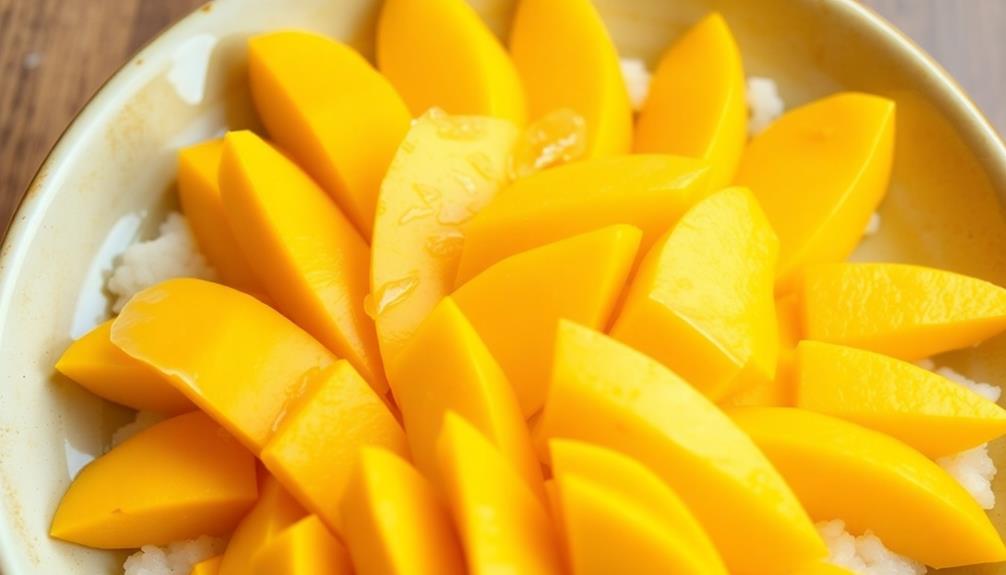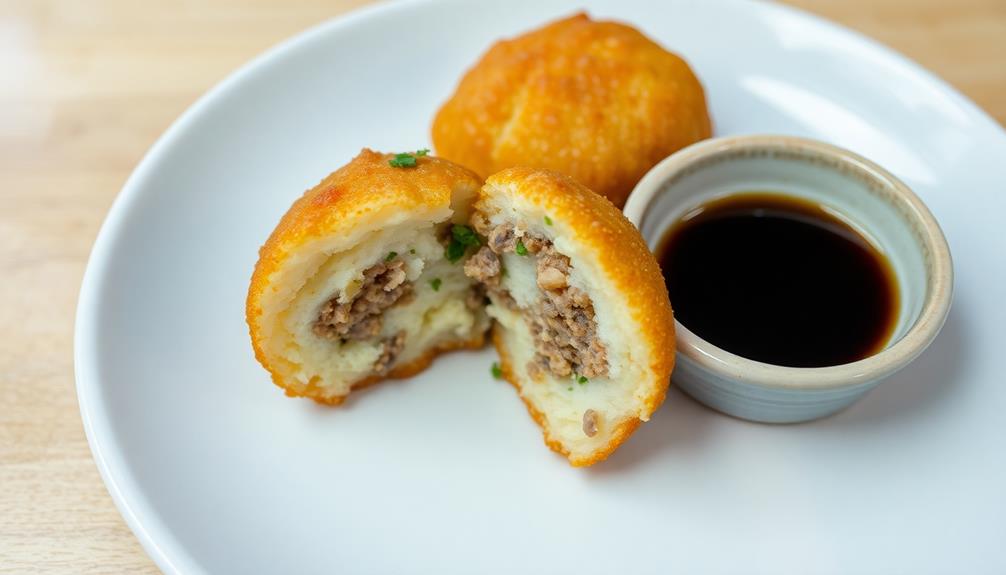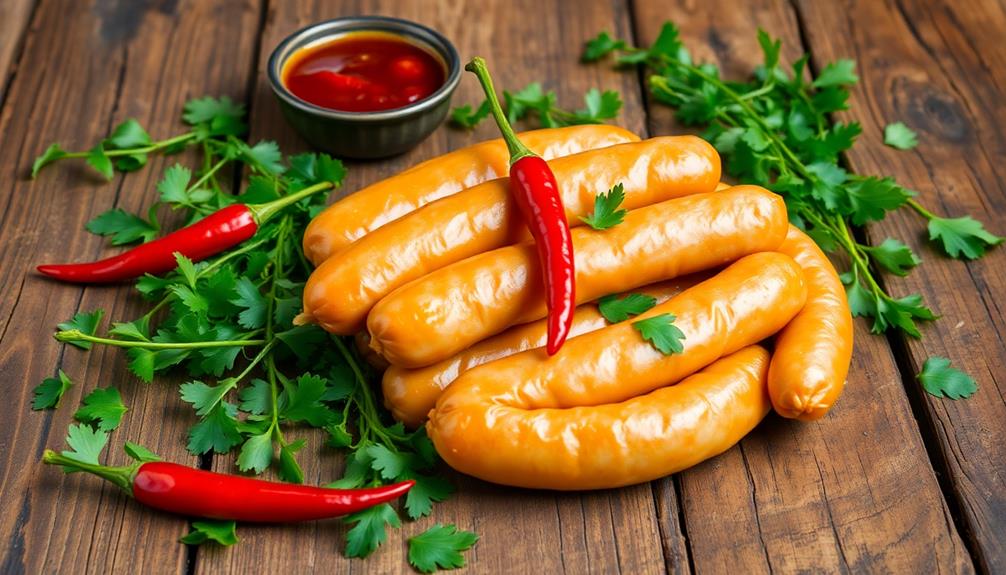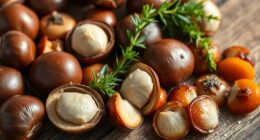Mango sticky rice, also known as Khao Niao Mamuang, is a beloved Thai dessert that'll tantalize your taste buds. This traditional treat combines the tropical sweetness of ripe mangoes with the rich, creamy texture of coconut-infused sticky rice. It's a beloved staple, often enjoyed during mango season or at special celebrations. To prepare it, you'll soak glutinous rice, steam it until tender and sticky, then mix it with a sweet coconut milk mixture. Top it off with fresh mango slices for a vibrant and delightful presentation. This beloved Thai dish showcases the country's culinary artistry and tradition – and there's more to discover about its fascinating history.
Key Takeaways
- Khao Niao Mamuang is a traditional Thai dessert that combines sweet mango and coconut-infused sticky rice, reflecting the nation's culinary heritage.
- The dish has roots dating back to the 13th century kingdom of Sukhothai, and it is now considered a national delicacy in Thailand.
- The key ingredients include glutinous rice, ripe mangoes, coconut milk, sugar, and salt, which are combined to create a harmonious balance of flavors.
- Proper preparation involves soaking the rice, steaming it until sticky, and then infusing it with a coconut milk-based mixture for maximum flavor absorption.
- Mango Sticky Rice is often served at festivals and special occasions, and its vibrant colors and rich taste have made it increasingly popular in international cuisine.
History
Mango sticky rice is a beloved Thai dessert that traces its roots to the country's ancient culinary traditions. For centuries, sticky rice and tropical fruits like mangoes have been staples in Thai cuisine, with their combination creating a beloved and iconic dish.
The origins of mango sticky rice are believed to date back to the 13th century, when the kingdom of Sukhothai first emerged as a major power in Southeast Asia. During this time, the dish likely evolved from simpler glutinous rice and fruit preparations into the more complex and refined version we know today.
Over the centuries, mango sticky rice has become deeply ingrained in Thai culture and is now considered a national dish, enjoyed by people of all ages and backgrounds.
The dish's popularity has even spread beyond Thailand's borders, with versions of it found in other Southeast Asian countries and around the world. Today, mango sticky rice remains a beloved and iconic part of Thailand's rich culinary heritage.
Recipe
Mango Sticky Rice is a beloved Thai dessert that combines the sweetness of ripe mangoes with the rich, creamy texture of sticky rice. This dish is a delightful balance of flavors and textures, making it a popular choice for both casual and formal occasions.
The key to achieving the perfect Mango Sticky Rice lies in the proper preparation of the sticky rice and the selection of high-quality, ripe mangoes. The sticky rice is typically soaked in water and then steamed until it becomes soft and sticky, while the mangoes are carefully peeled and sliced to showcase their natural sweetness.
- 1 cup sticky rice
- 1 cup coconut milk
- 1/2 cup sugar
- 1/4 teaspoon salt
- 2 ripe mangoes, peeled and sliced
In a pot, combine the sticky rice, coconut milk, sugar, and salt. Bring the mixture to a simmer, then reduce the heat to low, cover, and cook for 20-25 minutes, or until the rice is tender and the liquid has been absorbed.
Remove the pot from the heat and let the rice sit, covered, for an additional 10 minutes.
To serve, place the warm sticky rice in a serving dish and top with the sliced mangoes. The warm, sticky rice pairs perfectly with the cool, sweet mango, creating a delightful contrast in both temperature and texture.
For an extra touch of richness, consider drizzling a bit of the remaining coconut milk over the top. Enjoy this authentic Thai dessert and savor the flavors of the tropics.
Cooking Steps
First, you'll want to soak the glutinous rice overnight.
Then, steam the rice until it's tender and sticky.
Next, prepare a delightful coconut milk mixture to pour over the rice.
Step 1. Soak Glutinous Rice Overnight

Soak the glutinous rice overnight, allowing it to fully absorb the water. This step is crucial for the rice to achieve the perfect texture – soft and sticky on the inside, with a delicate chewiness.
Use a large bowl and fill it with enough water to cover the rice by about an inch. Let it sit at room temperature for 8-12 hours, or overnight.
Once the soaking is complete, drain the rice in a fine-mesh strainer. Give it a gentle rinse under cool running water to remove any excess surface starch.
This helps prevent the grains from sticking together too much during the cooking process. Shake the strainer a few times to remove as much water as possible.
The rice is now ready to be steamed, which is the next crucial step in making authentic Khao Niao Mamuang.
Step 2. Steam the Glutinous Rice

Once the rice has finished soaking, it's time to steam it to perfection.
Grab your steamer and fill the bottom with water, making sure it doesn't touch the rice basket. Bring the water to a boil over high heat.
While that's heating up, transfer the soaked glutinous rice into the steamer basket. Be careful not to pack it too tightly – you want the grains to have room to expand.
Once the water is boiling, carefully place the rice basket into the steamer. Cover it with a lid and let it steam for 20-25 minutes.
Keep an eye on the water level, topping it up if needed. The rice is ready when it's soft, sticky, and translucent. Fluff it gently with a fork to ensure even cooking.
Now your perfectly steamed glutinous rice is ready to be dressed up with sweet coconut milk and fresh mango.
Get ready for the flavors of Thailand to dance on your taste buds!
Step 3. Prepare Coconut Milk Mixture

Next, prepare the sweet coconut milk mixture that will coat the steamed glutinous rice. In a medium saucepan, combine the coconut milk, sugar, and salt.
Whisk the ingredients together and place the pan over medium heat. Bring the mixture to a gentle simmer, stirring occasionally, until the sugar has fully dissolved, about 5 minutes.
Be careful not to let the mixture boil, as that can cause the coconut milk to curdle. Once the sugar has dissolved, remove the pan from the heat and let the coconut milk mixture cool slightly.
This rich, creamy sauce will add a lovely sweetness and creaminess to the sticky rice. When the rice is ready, you'll pour this fragrant coconut milk over the top, allowing it to soak in and create the signature taste of authentic mango sticky rice.
Step 4. Pour Coconut Mixture Over Sticky Rice

1. Now it's time to pour the coconut milk mixture over the cooked sticky rice. This step adds the signature creamy, sweet flavor to the dish.
Gently pour the coconut mixture over the rice, making sure to evenly distribute it. You'll want to do this while the rice is still warm, as the heat will help the coconut milk soak in.
Use a spoon to gently fold the rice and coconut milk together, being careful not to overmix and make the rice mushy.
Once the rice is coated, let it sit for 5-10 minutes so the flavors can meld. The rice should now have a soft, sticky, and luscious texture, ready to be paired with the fresh mango.
This simple yet essential step takes the dish from good to great, so be sure to pour the coconut mixture with care.
Step 5. Garnish With Fresh Mango Slices

To finish off the dish, take the fresh, ripe mangoes and slice them into thin, decorative pieces.
Arrange the mango slices artfully around the edges of the serving dish, overlapping them slightly to create a beautiful presentation. The vibrant orange hue of the mangoes will provide a stunning contrast to the white sticky rice and the pools of rich coconut milk. To balance out the sweetness of the mangoes and the creaminess of the coconut milk, consider serving a tangy and spicy green papaya salad on the side. The refreshing and crunchy texture of the salad will complement the smoothness of the mango sticky rice. Additionally, the combination of flavors will provide a delightful contrast, making the dish a truly unforgettable culinary experience.
Once the mangoes are in place, you can add any final garnishes, like a sprinkle of toasted coconut flakes or a sprig of fresh mint.
These small touches will elevate the overall look and taste of the Khao Niao Mamuang.
With the mango slices arranged and the dish ready to serve, you can now invite your guests to enjoy this beloved Thai dessert.
The combination of the sweet, creamy sticky rice, the juicy mango, and the fragrant coconut will transport them to the tropical flavors of Thailand.
Final Thoughts
While mango sticky rice is a beloved Thai dessert, it's important to consider a few final thoughts. When serving, you'll want to ensure the rice is still warm, as the contrast of the cool, fresh mango and the warm, fragrant rice is part of the magic.
Don't be afraid to get creative with the presentation, too – you can arrange the mango slices in a fan or spiral pattern for a visually stunning dish.
Additionally, feel free to experiment with different types of mangoes, as their sweetness and texture can vary. Some prefer the bright, tangy flavor of green mangoes, while others love the lush, velvety richness of ripe yellow mangoes.
No matter which you choose, the key is to let the natural sweetness of the fruit shine. With these final tips in mind, you're well on your way to mastering the art of mango sticky rice and delighting your guests with this beloved Thai treat.
Frequently Asked Questions
What Is the Traditional Way to Serve Khao Niao Mamuang?
The traditional way to serve this dish is to arrange the warm sticky rice on a plate, then top it with fresh, sliced mango and a drizzle of sweet coconut milk. You'll often see it garnished with toasted sesame seeds or shredded coconut.
Can I Use Other Types of Rice Besides Sticky Rice?
You can use other types of rice besides sticky rice, but it won't be the traditional Khao Niao Mamuang. The key ingredient that makes this dish is the sticky, glutinous rice.
How Long Does Khao Niao Mamuang Typically Take to Prepare?
Preparing this dish typically takes around 30-45 minutes. You'll need to soak the rice, cook it, and then mix it with the coconut milk and sugar. Don't forget to garnish it with the ripe, fresh mango slices.
Is Khao Niao Mamuang a Popular Dish Throughout Thailand?
Is Khao Niao Mamuang a popular dish throughout Thailand? Absolutely! This beloved dessert can be found in every corner of the country, delighting locals and tourists alike with its irresistible flavors and textures.
Can I Make Khao Niao Mamuang With Canned or Frozen Mangoes?
You absolutely can make this dish with canned or frozen mangoes. While fresh mangoes may provide the most authentic flavor, the convenience of pre-prepared fruit makes it easy to enjoy this Thai classic year-round.









